Harlan’s Hawk, a distinctive subspecies of the Red-tailed Hawk (Buteo jamaicensis), stands as a captivating subject within the avian realm.
Named after the renowned American ornithologist Harry Church Oberholser, this subspecies exhibits a range of unique characteristics that set it apart.
Known for its striking dark plumage and variations in coloration, Harlan’s Hawk showcases a remarkable diversity that challenges conventional perceptions of the Red-tailed Hawk.
Found predominantly in western North America and noted for its elusive nature, this raptor presents an intriguing study in adaptation to diverse habitats.
Its distinctive features and varied color morphs contribute to its mystique, making Harlan’s Hawk a subject of fascination for birdwatchers, ornithologists, and nature enthusiasts seeking to unravel the intricacies of its biology, behavior, and evolutionary significance.
Exploring the life of Harlan’s Hawk unveils a compelling narrative of survival, adaptation, and the intricate dance between predator and prey in the vast landscapes it calls home.
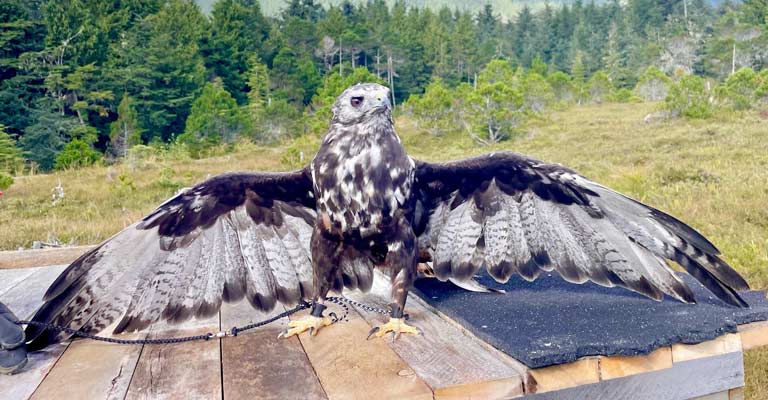
Identifying Characteristics of Harlan’s Hawk
Identifying Harlan’s Hawk (Buteo jamaicensis harlani) requires a nuanced understanding of its distinctive characteristics, as this subspecies of the Red-tailed Hawk boasts unique traits that set it apart.
Here are eight key points to aid in identifying Harlan’s Hawk:
Plumage Variation
One of the most striking features of Harlan’s Hawk is its diverse plumage. Unlike the typical Red-tailed Hawk, Harlan’s Hawk exhibits a range of color morphs, including dark and light variations.
The dark morph is characterized by chocolate-brown plumage with a contrasting light tail, while the light morph showcases lighter overall coloration.
Dark Head and Nape
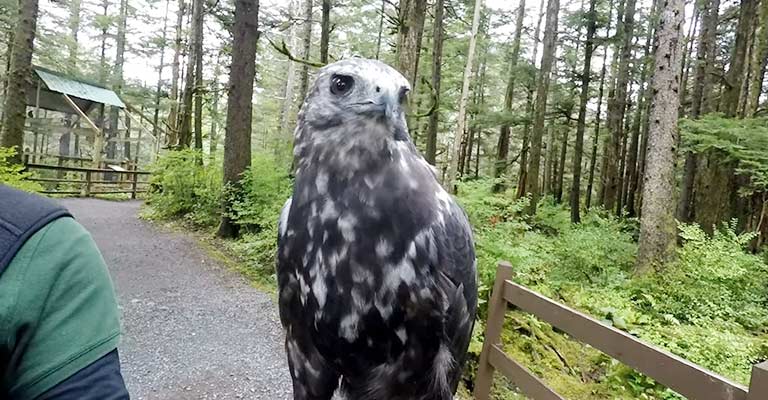
The dark morph of Harlan’s Hawk is particularly noteworthy for its uniformly dark head and nape.
This contrasts with the typical Red-tailed Hawk, where the head often shows a mottled pattern. The dark coloration extends down the nape, creating a distinctive hooded appearance.
Paler Undertail Coverts
In both dark and light morphs, Harlan’s Hawk typically features paler undertail coverts compared to the rest of the body. This can be a useful field mark when observing the bird from below.
Tail Banding
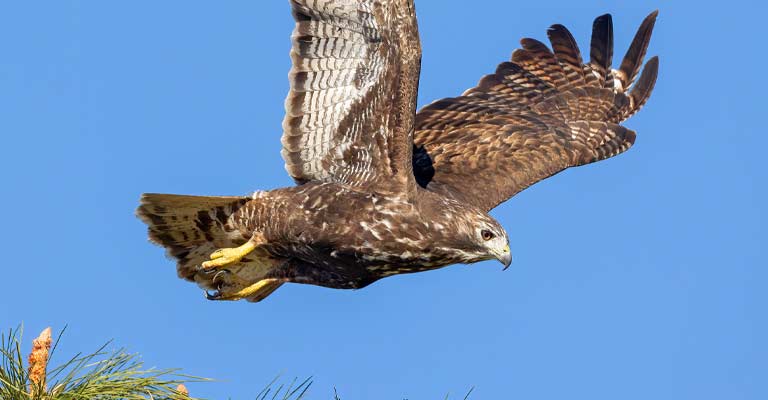
While the dark morph has a light tail, it often exhibits dark banding, creating a barred pattern. In contrast, the light morph may have a more uniform, pale tail with less pronounced banding.
Size and Shape
Harlan’s Hawk shares the general size and shape characteristics of the Red-tailed Hawk. It has a broad wingspan, sturdy build, and a characteristic soaring flight. The beak and talons are robust, reflecting its raptorial nature.
Facial Mask
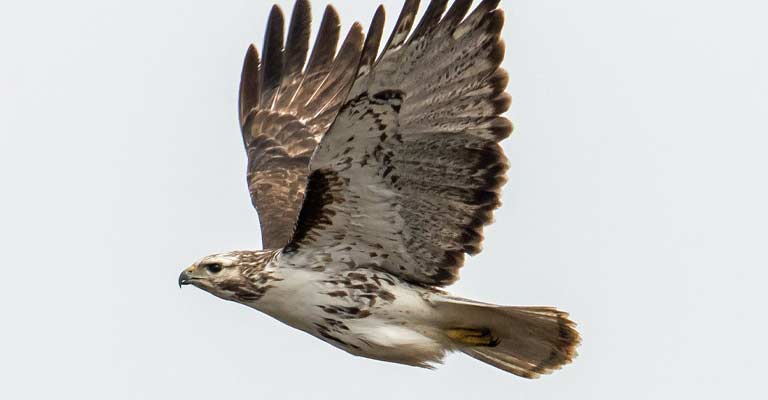
Some individuals of Harlan’s Hawk display a facial mask, which is a darker coloration around the eyes. This feature contributes to the bird’s overall distinctive appearance, emphasizing its focused and intense gaze.
Preferences of Living Area
Harlan’s Hawk is often associated with open country, including grasslands, agricultural areas, and scrublands.
It can also be found in mountainous regions during the breeding season. Observing the bird’s habitat can provide additional clues for identification.
Harlan’s Hawk presents birdwatchers with a captivating study of color variation and adaptation.
Recognizing the dark and light morphs, along with specific plumage features, facial characteristics, and habitat preferences, allows enthusiasts to distinguish this unique subspecies within the diverse world of raptors.
Taxonomy of Harlan’s Hawk
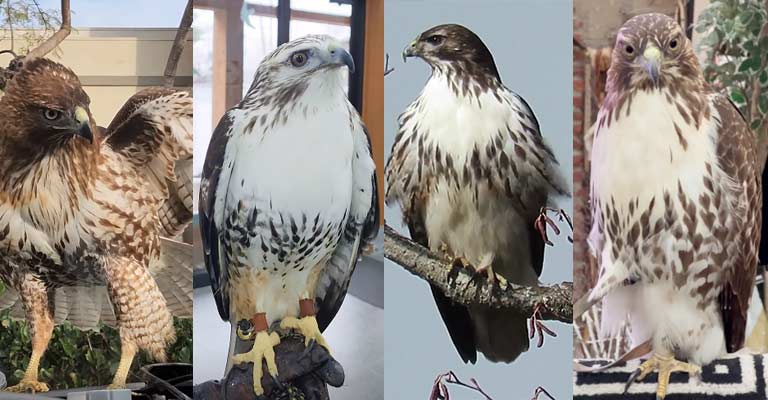
Here’s a table outlining the taxonomy details of Harlan’s Hawk (Buteo jamaicensis harlani):
| Taxonomic Rank | Classification |
| Domain | Eukaryota |
| Kingdom | Animalia |
| Phylum | Chordata |
| Class | Aves |
| Order | Accipitriformes |
| Family | Accipitridae |
| Genus | Buteo |
| Species | B. jamaicensis |
| Subspecies | B. j. harlani |
Harlan’s Hawk (Buteo jamaicensis harlani) is a bird of prey classified within the Animalia kingdom, Chordata phylum, Aves class, and Accipitriformes order.
It belongs to the Accipitridae family, and its genus is Buteo. Specifically, it is a subspecies of the Red-tailed Hawk (Buteo jamaicensis), distinguished by its unique plumage variations.
The taxonomy reflects its evolutionary lineage within the broader context of the animal kingdom, highlighting its avian characteristics and raptor family affiliations.
Harlan’s Hawk Life History
Harlan’s Hawk (Buteo jamaicensis harlani) presents a captivating life history, marked by its distinct characteristics and adaptations.
As a subspecies of the Red-tailed Hawk, this raptor’s life story unfolds against diverse habitats and ecological challenges.
Food
Harlan’s Hawk is a versatile predator, preying on a variety of small mammals, birds, and occasionally reptiles.
Its diet includes rodents, rabbits, and small birds, showcasing adaptability in hunting strategies, from soaring at high altitudes to low-level flights over open landscapes.
Habitat:
Adapting to diverse environments, Harlan’s Hawk can be found in open country, grasslands, agricultural areas, and mountainous regions.
Its habitat preferences vary seasonally, with breeding individuals seeking elevated nesting sites for better visibility.
Range Map
The geographical range of Harlan’s Hawk encompasses western North America, spanning from Alaska and Canada to the western United States. Understanding its range is crucial for conservation efforts and monitoring population dynamics.
Nesting
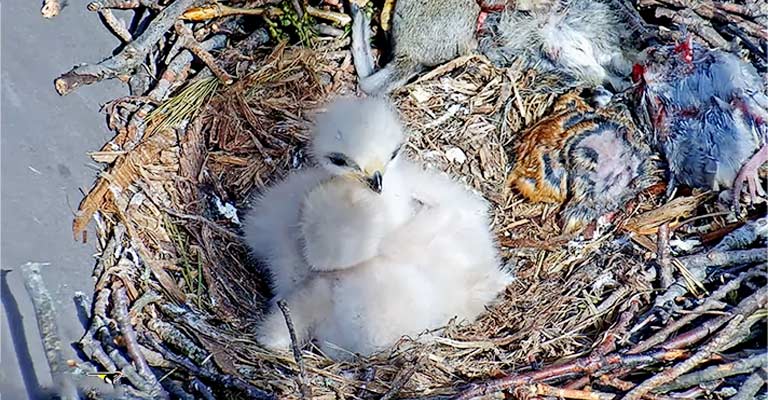
Nesting occurs in elevated locations such as cliffs, trees, or even man-made structures. The nest is constructed with sticks, and twigs, and lined with softer materials.
Harlan’s Hawk may reuse nests from previous years or those abandoned by other birds. Here’s a table summarizing nesting details for Harlan’s Hawk (Buteo jamaicensis harlani):
| Nesting Details | Information |
| Clutch Size | 1 to 5 eggs |
| Number of Broods | Typically 1 brood per breeding season |
| Egg Length | Approximately 57-74 mm (2.2-2.9 inches) |
| Egg Width | Approximately 45-55 mm (1.8-2.2 inches) |
| Incubation Period | About 28 to 35 days |
| Nestling Period | 42 to 46 days, fledging occurs around 6 weeks |
| Egg Description | Bluish-white or pale blue-green with light markings |
| Nest Type | Constructed on elevated sites, using sticks, and twigs, and lined with softer materials |
| Nest Location | Varied, including cliffs, trees, or man-made structures |
| Nest Material | Sticks, twigs, lined with softer materials |
| Parental Involvement | Both parents contribute to the incubation and care of the young |
| Nest Renewal Frequency | May reuse nests from previous years or abandoned nests of other birds |
Breeding
Breeding pairs engage in courtship displays, involving aerial acrobatics and mutual food exchanges. The female lays a clutch of 1 to 5 eggs, and both parents contribute to incubation and caring for the nestlings.
The fledglings remain dependent on parental care for several weeks after hatching.
Diseases
Like other raptors, Harlan’s Hawk can be vulnerable to diseases such as avian pox, West Nile virus, and other infections. Environmental factors and exposure to contaminated prey contribute to health concerns.
Treatment
In cases of disease or injury, rehabilitation centers play a vital role in providing medical care and rehabilitation for injured or sick individuals.
Prompt intervention by wildlife rehabilitators ensures the best chance for recovery and eventual release.
Conservation
Conservation efforts for Harlan’s Hawk focus on preserving its diverse habitats, ensuring suitable nesting sites, and minimizing threats like habitat loss and pesticide exposure.
Research and monitoring contribute to understanding population trends, and guiding targeted conservation actions for this unique raptor.
Harlan’s Hawk’s life history is a tale of adaptability and resilience, woven into the intricate fabric of the ecosystems it inhabits.
From its hunting prowess to reproductive strategies and the challenges it faces, each aspect of its life contributes to the broader narrative of raptor ecology and conservation.
10 Fun Facts About Harlan’s Hawk
Harlan’s Hawk (Buteo jamaicensis harlani) is an intriguing raptor with several fascinating traits that make it stand out in the avian world. Here are 10 fun facts about Harlan’s Hawk:
- Colorful Plumage: One of the most distinctive features of Harlan’s Hawk is its diverse plumage. It comes in various color morphs, ranging from dark chocolate-brown to lighter variations, showcasing the bird’s adaptability.
- Reversed Sexual Size Dimorphism: In a departure from the typical pattern in raptors, female Harlan’s Hawks are larger than males. This reversed sexual size dimorphism is a unique characteristic among birds of prey.
- Variable Tail Banding: The tail of Harlan’s Hawk, particularly in the dark morph, exhibits striking banding patterns. These dark bands on a lighter tail distinguish it from other Red-tailed Hawk subspecies.
- Versatile Habitat: Harlan’s Hawk is adaptable to a wide range of habitats, including open country, grasslands, agricultural areas, and mountainous regions. This adaptability contributes to its widespread distribution.
- Distinctive Facial Mask: Some individuals of Harlan’s Hawk display a facial mask, a darker coloration around the eyes. This feature adds to the bird’s overall striking appearance and intensity.
- Courtship Displays: During the breeding season, Harlan’s Hawk engages in elaborate courtship displays. These displays involve aerial acrobatics, mutual food exchanges, and vocalizations, strengthening the pair bond.
- Nesting on Elevated Sites: Harlan’s Hawk constructs nests on elevated sites such as cliffs, trees, or even man-made structures. This nesting behavior provides strategic vantage points for hunting and monitoring the surroundings.
- Diverse Diet: Their diet includes small mammals, birds, and occasionally reptiles. Their hunting strategies vary, from soaring high in the sky to low-level flights over open landscapes, showcasing adaptability in securing prey.
- Migratory Tendencies: While some populations are year-round residents, others exhibit migratory tendencies. Understanding their movements contributes to a comprehensive understanding of their ecology.
- Conservation Concerns: Harlan’s Hawk faces threats such as habitat loss and pesticide exposure. Conservation efforts are crucial to preserving their diverse habitats and ensuring their continued existence in the wild.
These fun facts highlight the uniqueness and adaptability of Harlan’s Hawk, making it a captivating subject for bird enthusiasts and ornithologists alike.
Wrapping Up
The journey through the captivating world of Harlan’s Hawk (Buteo jamaicensis harlani) unveils a tapestry of diversity and adaptability within the realm of raptors.
From its reversed sexual size dimorphism to the myriad of plumage variations, each facet of this hawk’s existence tells a story of resilience and survival.
The bird’s versatile habitat preferences, courtship displays, and unique nesting behaviors provide a window into its ecological significance and the intricate dance between predator and prey.
As we delve into the nuances of Harlan’s Hawk, it becomes evident that this raptor, with its distinctive features and migratory tendencies, is not merely a bird of prey but a sentinel of the diverse landscapes it calls home.
Conservation efforts become paramount to safeguarding the habitats crucial to its existence, ensuring that future generations can continue to marvel at the beauty and adaptability of Harlan’s Hawk in the ever-changing tapestry of the natural world.